Photo Evelyn Wendel Photo
Evelyn Wendel
Photo
Evelyn Wendel
The Making of The Spirit in Architecture
July 28, 2001 - Bette Jane Cohen
There are so many stories about the making of the documentary film, "The
Spirit in Architecture: John Lautner"... One of the best things was
that I was able to actually make the film in John Lautner's lifetime! I
think it meant a lot to him. I remember after the Museum of Contemporary
Art premiere someone in his family came up to me and said, "... Now
I understand what my father does." That meant a lot to me!
I made the film over ten years ago and a lot has changed technically. One
of the biggest changes is digital technology. I shot the Lautner film in
16 mm, interviews were 1/4 inch tape and cassette which were transferred
to 16 mm magnetic stock and I edited on a 16mm steenbeck. Today I edit on
a computer and I shoot digitally. It is all pretty amazing.
Another thing which comes to mind was a conversation I had in 1988 with
the late architect Anthony Greenberg. I was telling him I was in architecture
school at Southern California Institute of Architecture and I was telling
him about what I was really interested in architecture. He had asked me
if I had seen the work of John Lautner? Well, I started to research Lautner's
work and I stumbled on the Garcia House (The Rainbow House) the owner invited
me in and said there was going to be a Los Angeles Conservancy Tour on Lautner
and asked if I would like to be his guest. I went inside the Carling House
for the first time, the living room was on a hinge and the pool was inside
and outside the living room, the Silvertop House, Lautner's own house and
a few others were on the tour. The owner of the Garcia House said to me,
"... you seem so interested in Lautner's work you should go to Lautner's
office; it's right on Hollywood Boulevard".
At the time I made the film no books were written on Lautner. Several magazine
articles but there had not been a book published on his work. I went to
John Lautner's office and I collected a bibliography of his work. Lautner
was not there at the time but Julia Strictland was there. Marlene Laskey
had interviewed Lautner for UCLA's Oral History Program, she wrote "Responsibility,
Infinity and Nature" which was on the bibliography. I went to the University
of California Los Angeles and listened to the tapes of the interview and
it was during that time I was able to visualize the film. It became clear
that there were many ideas that he was talking about and he wished he could
show visually. I thought film would be a wonderful format to portray these
ideas and complex flowing spaces and describe the creative forces behind
them.
I started to write a National Endowment for the Arts grant. I told a friend
of mine about the project and he said to me, "You are making a film
on a man who you have never met and has not given you his permission? What
are you crazy?" I called Lautner's office the next day to make an appointment
with John Lautner. I went into Lautner's office with my proposal and introduced
myself. I had never made a film before but I had been a film editor on many
films. He said, "Well it seems like a worthwhile project and you seem
tall enough to do it!" That is how we started working together.
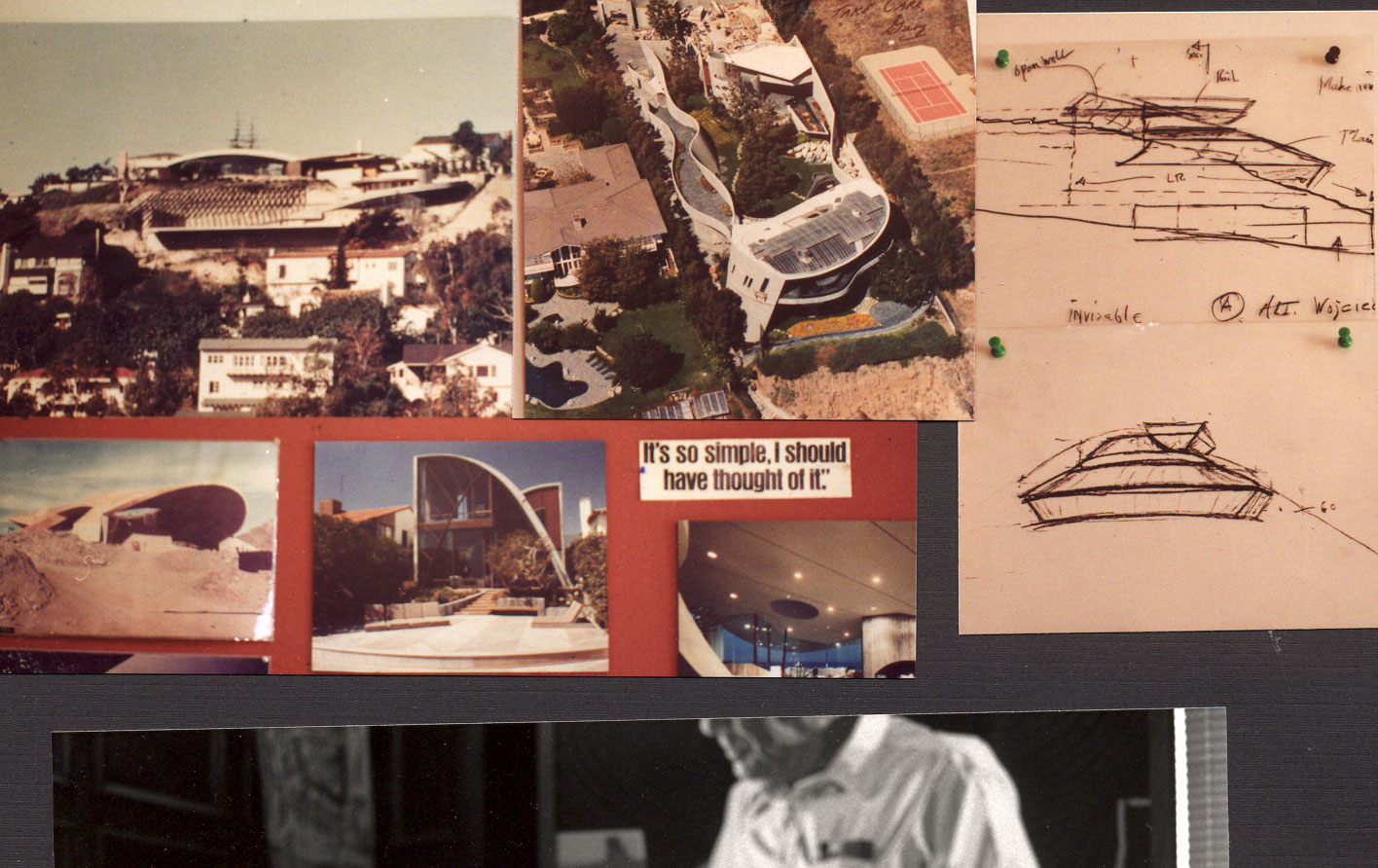 Photo
Bette Cohen
Several months later I went back to see Tony Greenberg and I told him I
had not only seen the work of John Lautner but that I was making a film
on his work.
I had started to make the film way before I had any funding at all. It was
an idea in my head but I could visualize it and I knew nothing like it had
been done before. Co-producer and co-writer Evelyn Wendel and I began collaborating
while she was employed in the Motion Picture Group at Paramount Pictures.
Isabel Coulet, Jeanice Deeb and Ann Gray became involved.
I had never intended to direct the film. I was looking for a director. Funding
was so difficult for the project we decided to start shooting anyway. We
had planned our first 16mm shoot with John Lautner at the Chemosphere House.
Bernard Salzmann was the first cinematographer. He
said to me, "You direct it!" So I did. We rented a camera,
got a sound man, and started to shoot. After that first shoot Ann Gray and
Evelyn Wendel helped to get support from Paramount Studios. We would shoot
and edit and shoot and edit... I remember the hours and hours of interviews
with John sometimes I could afford to run film and sometime I could only
use a tape recorder. It was always a challenge interviewing
him.
Photo
Bette Cohen
Several months later I went back to see Tony Greenberg and I told him I
had not only seen the work of John Lautner but that I was making a film
on his work.
I had started to make the film way before I had any funding at all. It was
an idea in my head but I could visualize it and I knew nothing like it had
been done before. Co-producer and co-writer Evelyn Wendel and I began collaborating
while she was employed in the Motion Picture Group at Paramount Pictures.
Isabel Coulet, Jeanice Deeb and Ann Gray became involved.
I had never intended to direct the film. I was looking for a director. Funding
was so difficult for the project we decided to start shooting anyway. We
had planned our first 16mm shoot with John Lautner at the Chemosphere House.
Bernard Salzmann was the first cinematographer. He
said to me, "You direct it!" So I did. We rented a camera,
got a sound man, and started to shoot. After that first shoot Ann Gray and
Evelyn Wendel helped to get support from Paramount Studios. We would shoot
and edit and shoot and edit... I remember the hours and hours of interviews
with John sometimes I could afford to run film and sometime I could only
use a tape recorder. It was always a challenge interviewing
him.
 Photo
Bette Cohen
Alan Blaisell and I shot in John's office and shot models on the roof.
He was also with me when we shot the exterior of Lautner's own first home.
Throughout the project I worked with about fourteen different cinematographers.
They all contributed something amazing to the film. They were all challenged
and inspired by Lautner and the project. I got Directors of Photography
from agents, directors and producers I had worked with in the past. My friend
Carl Bressler was an agent representing cinematographers and editors. He
knew of a woman editor from Canada, Michel Jones, and gave her my number.
She became a dear friend, co editor and co writer. Carl also helped me find
different cinematographers to work with. One of Carl's Directors of Photography
was an aerial DP named Stan McClain. One day Stan called me, "I have
a 35 mm camera and a helicopter all you have to pay for is gas and film
and processing. Do you want to shoot?" Well, gas from Burbank to Malibu
cost a lot and 35 mm film and a 16mm film reduction cost a lot but the shot
really does help communicate the extraordinary space. It was quite an experience.
Photo
Bette Cohen
Alan Blaisell and I shot in John's office and shot models on the roof.
He was also with me when we shot the exterior of Lautner's own first home.
Throughout the project I worked with about fourteen different cinematographers.
They all contributed something amazing to the film. They were all challenged
and inspired by Lautner and the project. I got Directors of Photography
from agents, directors and producers I had worked with in the past. My friend
Carl Bressler was an agent representing cinematographers and editors. He
knew of a woman editor from Canada, Michel Jones, and gave her my number.
She became a dear friend, co editor and co writer. Carl also helped me find
different cinematographers to work with. One of Carl's Directors of Photography
was an aerial DP named Stan McClain. One day Stan called me, "I have
a 35 mm camera and a helicopter all you have to pay for is gas and film
and processing. Do you want to shoot?" Well, gas from Burbank to Malibu
cost a lot and 35 mm film and a 16mm film reduction cost a lot but the shot
really does help communicate the extraordinary space. It was quite an experience.
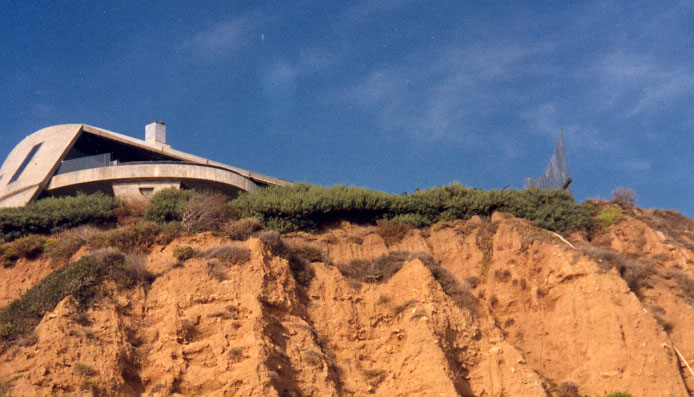 Photo
Bette Cohen
Early on in the film I knew I need to go to Taliesin West in Phoenix where
John Lautner apprenticed with Frank Lloyd Wright. I got into my car and
drove to Phoenix and called Taliesin. I made an appointment with the person
in charge who happened to be the late architect William Wessley Peters who
had been an apprentice with John at Taliesin. He said to me how can I help
you? They opened their archives to me and allowed me to shoot whatever I
needed for the film. I had been corresponding with Bruno Zevi the late architectural
critic in Rome where I was able to film him. It was quite a challenge to
organize a 16mm film shoot in Rome but some how I found a crew and I did
it. I was also able to interview the late architectural historian Esther
McCoy and the late architectural historian David Gebhard as well. Architectural
historians Alan Hess and Ken Breisch were also very helpful.
When I went back to Taliesin to shoot with a great crew we had just landed
in Phoenix and rented a truck for us and all our gear. The cinematographer,
Toni Palmeri, said to me "Where is John?" I had not planned for
him to be there with us. I called John from the truck while driving on the
highway and I said it might be a good idea if he came to Taliesin with us.
Well he jumped on a plane with his wife Francesca. He took us to the spot
out in the desert where he built his first structure. He showed us where
he would work and eat... It made it so special that he could be there with
us.
Photo
Bette Cohen
Early on in the film I knew I need to go to Taliesin West in Phoenix where
John Lautner apprenticed with Frank Lloyd Wright. I got into my car and
drove to Phoenix and called Taliesin. I made an appointment with the person
in charge who happened to be the late architect William Wessley Peters who
had been an apprentice with John at Taliesin. He said to me how can I help
you? They opened their archives to me and allowed me to shoot whatever I
needed for the film. I had been corresponding with Bruno Zevi the late architectural
critic in Rome where I was able to film him. It was quite a challenge to
organize a 16mm film shoot in Rome but some how I found a crew and I did
it. I was also able to interview the late architectural historian Esther
McCoy and the late architectural historian David Gebhard as well. Architectural
historians Alan Hess and Ken Breisch were also very helpful.
When I went back to Taliesin to shoot with a great crew we had just landed
in Phoenix and rented a truck for us and all our gear. The cinematographer,
Toni Palmeri, said to me "Where is John?" I had not planned for
him to be there with us. I called John from the truck while driving on the
highway and I said it might be a good idea if he came to Taliesin with us.
Well he jumped on a plane with his wife Francesca. He took us to the spot
out in the desert where he built his first structure. He showed us where
he would work and eat... It made it so special that he could be there with
us.
 John Lautner, Frank Lloyd Wright, Edgar Tafel, William Wesley Peters
John Lautner needed to go to the Elrod House in Palm Springs. I was able
to arrange to film there at the time and stay in the house overnight with
my crew. We also went to the desert Hot Springs Motel with John. He had
not been out there since he had built it. Steven Finestone was the cinematographer
for that sequence. He was very inventive and was able to do a lot with a
small budget.
John Lautner, Frank Lloyd Wright, Edgar Tafel, William Wesley Peters
John Lautner needed to go to the Elrod House in Palm Springs. I was able
to arrange to film there at the time and stay in the house overnight with
my crew. We also went to the desert Hot Springs Motel with John. He had
not been out there since he had built it. Steven Finestone was the cinematographer
for that sequence. He was very inventive and was able to do a lot with a
small budget.
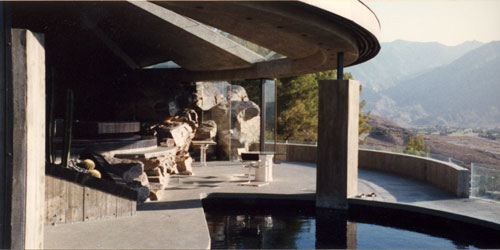 Photo
Bette Cohen
We shot at the Elrod House until the sun went down and shot the sun coming
up. It was spectacular to be documenting that space. I will never forget
it.
Photo
Bette Cohen
We shot at the Elrod House until the sun went down and shot the sun coming
up. It was spectacular to be documenting that space. I will never forget
it.
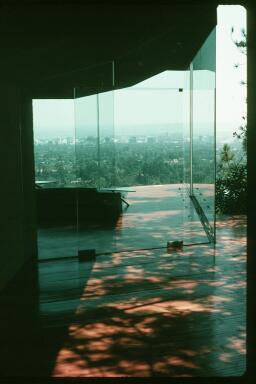 Photo
Bette Cohen
Darin Okada shot with me at the Sheats Goldstein House.
Another really special thing happened one day while I was in the editing
room. I got a call from Carter Manny from the Graham Foundation. He had
worked with John at Frank Lloyd Wright's Taliesin and knew his work. He
said they wanted to help us with our project. We not only got support from
Paramount but we had gotten our first grant. Latter I got a Grant from the
City of Los Angeles Cultural Affairs Department and the Architectural Foundation.
Photo
Bette Cohen
Darin Okada shot with me at the Sheats Goldstein House.
Another really special thing happened one day while I was in the editing
room. I got a call from Carter Manny from the Graham Foundation. He had
worked with John at Frank Lloyd Wright's Taliesin and knew his work. He
said they wanted to help us with our project. We not only got support from
Paramount but we had gotten our first grant. Latter I got a Grant from the
City of Los Angeles Cultural Affairs Department and the Architectural Foundation.
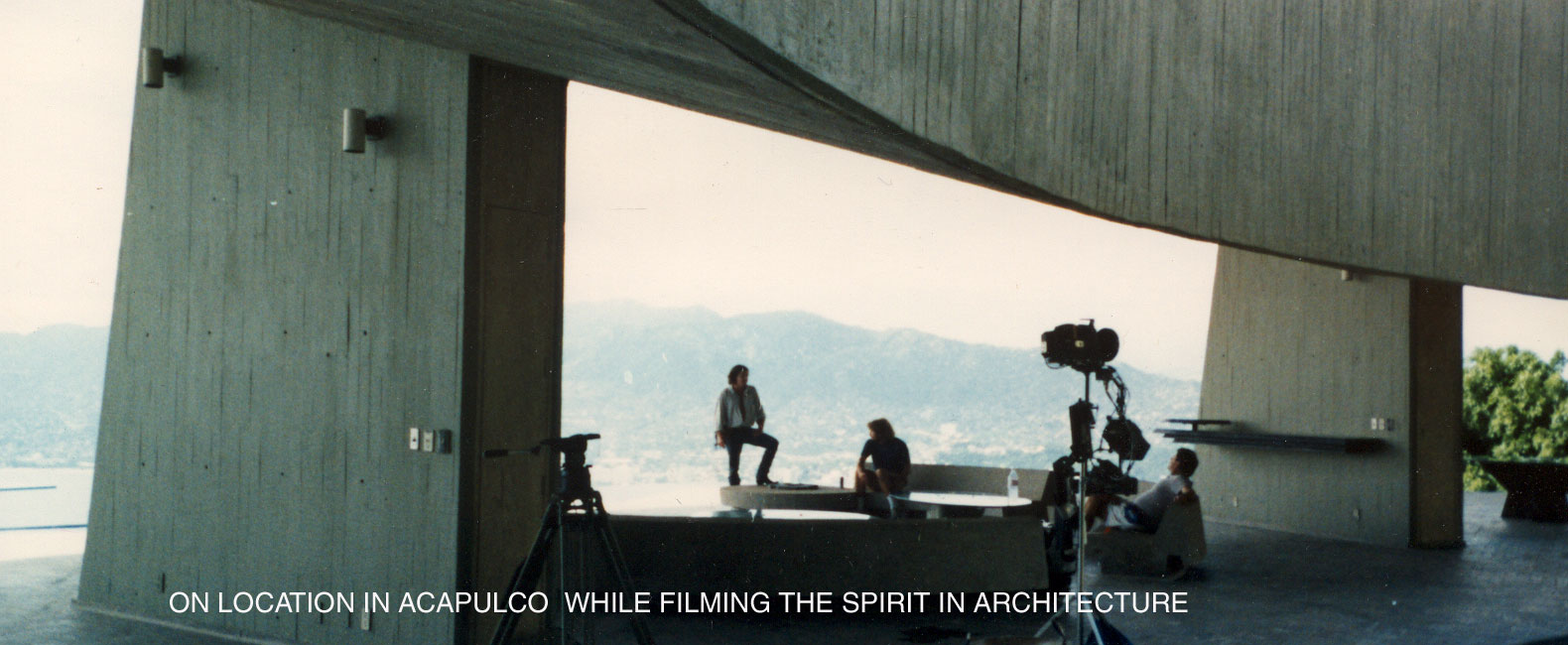 Photo
Bette Cohen
We were also able to film in Acapulco at the Arango House. Steven Finestone,
Jack Walner and Dan Kneece joined us for that sequence.
We were able shoot the time-lapse sequence in the bedroom. A few years
later after I had finished the film we had both gone together for the screening
at Taliesin West in Phoenix, in Vancouver BC, Vienna, the University of
Michigan in Marquette his home town, and Harvard University in Cambridge
where there was an exhibition of his work and he was invited to lecture.
I screened the film at the Pompidou Center in Paris, the House of Architecture
in Moscow, an architecture film festival in Bordeaux France and Viterbo
Italy, the Exploratorium in San Francisco, the Northwest Film Center in
Portland Oregon, the University of Washington in Seattle and the Pratt Institute
in New York City...
I get the same feeling today as I got the first time I was ever in one of
Lautner's spaces, no matter how large or grand it always makes you think
about where you are (the light, nature, ) and adds something very special
to your life it is a feeling of timeless enduring space it just keeps going...
It is really wonderful to see all his structures being restored so beautifully.
I know it would have made him very happy!
Photo
Bette Cohen
We were also able to film in Acapulco at the Arango House. Steven Finestone,
Jack Walner and Dan Kneece joined us for that sequence.
We were able shoot the time-lapse sequence in the bedroom. A few years
later after I had finished the film we had both gone together for the screening
at Taliesin West in Phoenix, in Vancouver BC, Vienna, the University of
Michigan in Marquette his home town, and Harvard University in Cambridge
where there was an exhibition of his work and he was invited to lecture.
I screened the film at the Pompidou Center in Paris, the House of Architecture
in Moscow, an architecture film festival in Bordeaux France and Viterbo
Italy, the Exploratorium in San Francisco, the Northwest Film Center in
Portland Oregon, the University of Washington in Seattle and the Pratt Institute
in New York City...
I get the same feeling today as I got the first time I was ever in one of
Lautner's spaces, no matter how large or grand it always makes you think
about where you are (the light, nature, ) and adds something very special
to your life it is a feeling of timeless enduring space it just keeps going...
It is really wonderful to see all his structures being restored so beautifully.
I know it would have made him very happy!
 Photo
Evelyn Wendel
Photo
Evelyn Wendel
FOR MORE INFORMATION CONTACT: BETTE COHEN